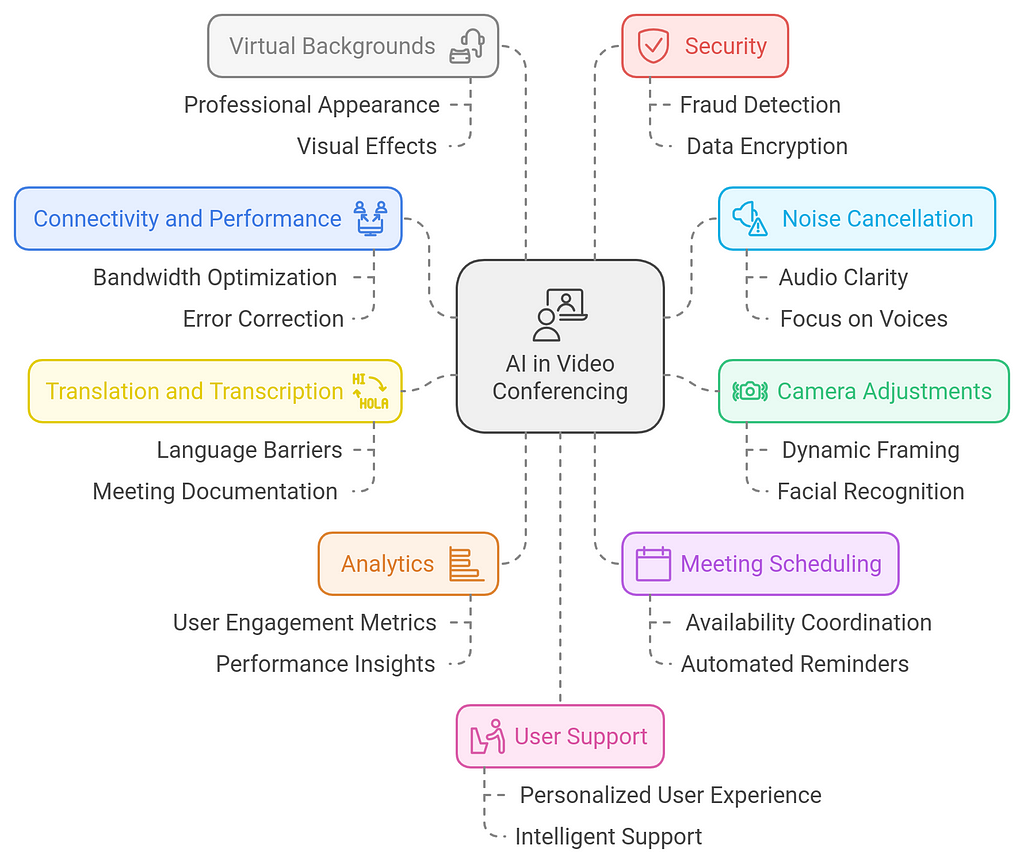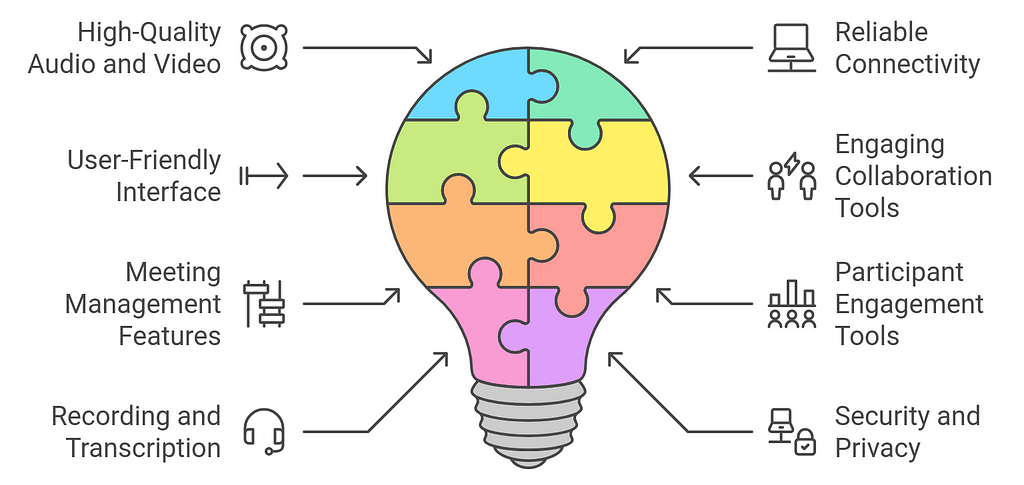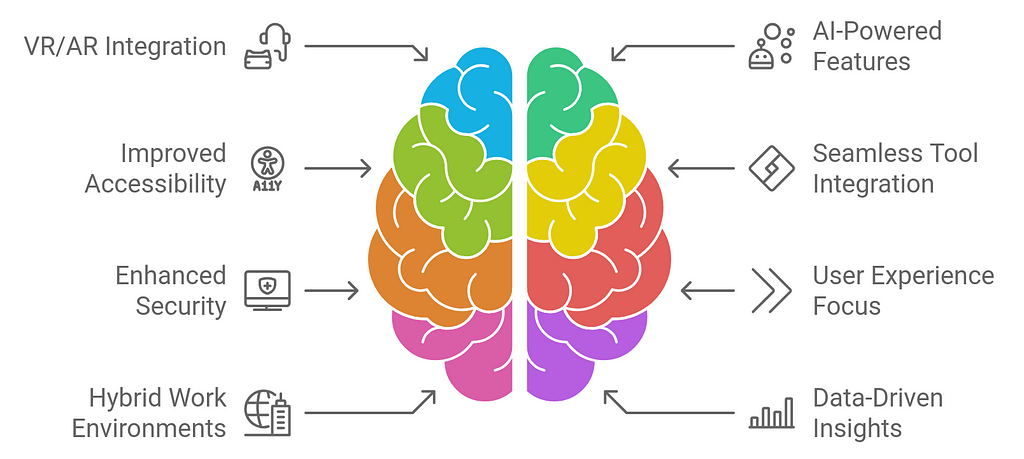OpenAI Expands Its Content With Major Media Deals.
As technology continues to evolve, the landscape of AI video conferencing platforms is being significantly shaped by future associations and partnerships. These collaborations bring together diverse expertise and innovative perspectives, enabling the development of advanced features that enhance user experience and productivity. By combining resources, companies can leverage artificial intelligence to improve functionalities like real-time translation, automatic transcription, and intelligent meeting analytics. Furthermore, partnerships with academic institutions and research organizations foster cutting-edge research, driving the development of more sophisticated algorithms and user-friendly interfaces.

As businesses increasingly embrace remote work and global collaboration, the demand for seamless communication tools continues to rise. Future associations in this space not only accelerate technological advancements but also help address security concerns and ensure compliance with data protection regulations. Ultimately, the evolution of AI video conferencing platform development will hinge on these strategic alliances, paving the way for innovative solutions that redefine how individuals and organizations connect, collaborate, and communicate in an increasingly digital world.
Table of ContentUnderstanding Artificial IntelligenceWhat is AI Video Conferencing Platform Development?
Current State of AI in Video Conferencing
Benefits of AI-Based Video Conferencing
How AI Technology Can Make Video Conferencing More Reliable
How to Make Video Conferencing Impeccable with Vital Features
Innovations Driven by Associations
Challenges and Opportunities
The Future of Video Conferencing in the Coming Era
ConclusionUnderstanding Artificial Intelligence
Understanding artificial intelligence (AI) involves recognizing it as a branch of computer science focused on creating systems capable of performing tasks that typically require human intelligence. These tasks include learning from experience, reasoning, problem-solving, understanding natural language, and recognizing patterns. AI technologies are often categorized into two types: narrow AI, which is designed for specific tasks (like virtual assistants or recommendation systems), and general AI, which aims to perform any intellectual task that a human can do.
Machine learning, a subset of AI, enables systems to improve their performance over time by analyzing data and identifying patterns without explicit programming. Deep learning, another subfield, utilizes neural networks to process vast amounts of data, enhancing capabilities in areas like image and speech recognition.
As AI continues to evolve, its applications are becoming increasingly prevalent in various sectors, including healthcare, finance, and transportation, transforming how we work, communicate, and solve complex problems. Understanding these concepts is essential for leveraging AI’s potential in today’s technology-driven world.
What is AI Video Conferencing Platform Development?AI video conferencing platform development refers to the process of creating and enhancing digital communication tools that leverage artificial intelligence technologies to facilitate virtual meetings and collaborations. These platforms integrate various AI capabilities, such as natural language processing, machine learning, and computer vision, to provide users with advanced features that improve the overall meeting experience. For instance, AI can enable real-time translation and transcription, ensuring seamless communication among participants from different linguistic backgrounds. Additionally, intelligent algorithms can analyze user interactions to provide insights on engagement levels and optimize meeting dynamics.
The development process often involves continuous iteration and improvement based on user feedback, technological advancements, and emerging trends in remote work. As organizations increasingly rely on virtual collaboration, AI video conferencing platforms aim to offer not only reliable connectivity but also enhanced functionalities that cater to diverse needs, such as security, accessibility, and user-friendly interfaces. Ultimately, this development strives to create a more efficient, inclusive, and productive virtual communication environment that meets the demands of a rapidly evolving digital landscape.
Current State of AI in Video ConferencingThe current state of AI in video conferencing is marked by significant advancements that enhance user experience and productivity. Many platforms now incorporate features such as real-time transcription, automatic translation, and facial recognition to improve communication and engagement during meetings. AI-driven analytics tools provide insights into participant interactions, helping organizers gauge engagement levels and optimize meeting effectiveness.
Additionally, AI technologies assist in background noise reduction and image enhancement, ensuring clearer audio and video quality. Security measures are also bolstered through AI, which helps detect unusual behavior and potential threats in real time. As remote work continues to be a norm, the integration of AI in video conferencing platforms is expected to expand, driving innovation and fostering seamless, inclusive communication across diverse teams and geographies.
Benefits of AI-Based Video ConferencingAI-based video conferencing solutions are revolutionizing how individuals and organizations communicate and collaborate. Here are some of the key benefits of using AI in video conferencing:
 1. Improved Audio and Video Quality
1. Improved Audio and Video Quality- Noise Cancellation: AI algorithms filter out background noise and enhance voice clarity, ensuring participants can communicate clearly, even in noisy environments.
- Adaptive Video Quality: AI optimizes video resolution based on available bandwidth, providing a smoother experience without interruptions.
- Automatic Transcription: AI can generate real-time transcripts of meetings, allowing participants to refer back to discussions and decisions easily.
- Language Translation: AI-powered translation features enable real-time language conversion, facilitating communication among participants who speak different languages.
- Dynamic Framing and Focus: AI can automatically adjust camera angles and zoom levels to keep speakers properly framed and in focus, enhancing the visual experience.
- Smart Meeting Layouts: AI can customize the layout of video feeds based on speaker activity, ensuring that the most relevant participants are highlighted.
- Meeting Scheduling: AI tools can analyze calendars and suggest optimal meeting times, reducing scheduling conflicts and streamlining the process.
- Agenda Setting and Follow-ups: AI can automatically generate meeting agendas based on previous discussions and follow-up reminders after the meeting.
- Engagement Metrics: AI can analyze participant engagement during meetings, providing insights into attentiveness and interaction levels to improve future meetings.
- Performance Tracking: AI can monitor connection quality and meeting duration, offering insights for optimizing the video conferencing experience.
- Seamless Tool Integration: AI-based video conferencing solutions can easily integrate with other collaboration tools, such as project management software and document-sharing platforms, enabling a more cohesive workflow.
- Real-Time Collaboration: Participants can collaborate in real-time on shared documents and presentations during video calls, enhancing productivity.
- Fraud Detection: AI can monitor participant behavior for unusual activity, helping to identify potential security threats and unauthorized access.
- Data Encryption: AI technologies can enhance encryption protocols, ensuring secure communications and compliance with privacy regulations.
- Adaptive Learning: AI can learn from user preferences and behaviors, customizing the video conferencing experience for individuals and teams.
- Intelligent Support: AI chatbots can provide immediate technical support during meetings, helping users troubleshoot issues without interrupting the flow of the call.
- Reduced Travel Costs: AI-based video conferencing allows for effective remote communication, reducing the need for business travel and associated expenses.
- Increased Productivity: With features like automatic scheduling and enhanced collaboration tools, teams can save time and focus on their work rather than administrative tasks.
- Adaptable Solutions: AI-powered video conferencing platforms can scale to accommodate different group sizes, from one-on-one meetings to large webinars, making them suitable for various business needs.
- Remote Accessibility: AI enables seamless participation from anywhere, ensuring that teams can collaborate effectively regardless of their physical location.
AI-based video conferencing offers numerous advantages, including improved communication quality, enhanced user experiences, and increased collaboration. As organizations increasingly rely on remote work and global teams, leveraging AI technology in video conferencing will become essential for maintaining effective communication and productivity. With its ability to automate tasks, provide valuable insights, and enhance security, AI is set to redefine the future of virtual meetings and collaboration.
How AI Technology Can Make Video Conferencing More ReliableAI technology is transforming video conferencing by enhancing its reliability, usability, and overall experience. Here are several ways AI can make video conferencing more dependable:
 1. Enhanced Connectivity and Performance
1. Enhanced Connectivity and Performance- Bandwidth Optimization: AI algorithms can analyze network conditions in real time, adjusting video quality and stream settings to optimize bandwidth usage and minimize interruptions during calls.
- Error Correction: AI can detect packet loss and automatically implement error correction techniques, improving video and audio quality even in suboptimal network conditions.
- Audio Clarity: AI-powered noise suppression algorithms can filter out background noise, such as keyboard typing or ambient sounds, ensuring clearer communication during meetings.
- Focus on Voices: AI can distinguish between human voices and background sounds, allowing for enhanced audio quality by prioritizing speech frequencies.
- Dynamic Framing: AI can automatically adjust camera angles and zoom levels to keep participants framed correctly, enhancing the visual quality of the meeting.
- Facial Recognition: AI technology can detect who is speaking and switch the focus to that participant, ensuring that the most relevant speaker is highlighted.
- Language Barriers: AI can provide real-time translation of spoken words, making it easier for participants who speak different languages to communicate effectively.
- Meeting Documentation: Automatic transcription features powered by AI can generate accurate meeting notes, making it easier to track discussions and decisions.
- User Engagement Metrics: AI can analyze engagement levels during video calls, such as participant attentiveness and interaction rates, helping organizations understand how effectively meetings are conducted.
- Performance Insights: By tracking connection quality, call duration, and user behavior, AI can provide insights for improving future video conferencing sessions.
- Availability Coordination: AI tools can analyze participants’ calendars and suggest optimal meeting times, minimizing scheduling conflicts and enhancing attendance rates.
- Automated Reminders: AI can send automated reminders to participants, ensuring everyone is aware of upcoming meetings and reducing no-show rates.
- Professional Appearance: AI can create virtual backgrounds or enhance existing ones, allowing participants to maintain a professional appearance, regardless of their physical environment.
- Visual Effects: Features like blurring the background can help reduce distractions, allowing participants to focus on the discussion.
- Fraud Detection: AI can monitor user behavior during video calls to identify potential security threats, such as unauthorized access or suspicious activity.
- Data Encryption: AI technologies can help enhance encryption protocols, ensuring that video conferencing data is secure and compliant with privacy regulations.
- Personalized User Experience: AI can learn from user preferences and behaviors, customizing the video conferencing experience for individuals or teams, leading to a more efficient workflow.
- Intelligent Support: AI chatbots can provide immediate support during calls, addressing technical issues or questions without interrupting the flow of the meeting.
- Collaboration Features: AI can enable smoother integration with collaboration tools (e.g., project management software, document sharing) within the video conferencing platform, making it easier to share files and collaborate in real time.
- Cross-Platform Compatibility: AI can help ensure compatibility between different video conferencing platforms, allowing users to connect seamlessly across various applications.
AI technology significantly enhances the reliability of video conferencing by improving connectivity, audio and video quality, and user experience. By leveraging AI’s capabilities, organizations can facilitate more productive meetings, ensure clearer communication, and foster collaboration among remote teams. As AI continues to evolve, the potential for more innovative and reliable video conferencing solutions will only grow, making it an essential tool in today’s digital landscape.
How to Make Video Conferencing Impeccable with Vital FeaturesTo create an impeccable video conferencing experience, it’s essential to incorporate key features and best practices that enhance communication, engagement, and collaboration. Here’s how to achieve that:
 1. High-Quality Audio and Video
1. High-Quality Audio and Video- Use High-Definition Cameras: Invest in high-quality webcams and microphones to ensure clear video and audio. HD cameras improve visual clarity, while quality microphones capture sound accurately, minimizing misunderstandings.
- Employ AI-Powered Noise Cancellation: Implement noise cancellation technologies to filter out background noise and enhance voice clarity during calls.
- Ensure Stable Internet Connection: Use wired connections where possible, as they tend to be more stable than Wi-Fi. Ensure all participants have a reliable internet connection to minimize disruptions.
- Bandwidth Management: Use platforms that dynamically adjust video quality based on bandwidth availability, ensuring smooth communication even in lower bandwidth scenarios.
- Intuitive Navigation: Choose a video conferencing platform with a user-friendly interface that is easy for all participants to navigate. Clear buttons for muting, camera control, and screen sharing enhance the user experience.
- Mobile Compatibility: Ensure the platform is mobile-friendly, allowing participants to join from various devices without complications.
- Screen Sharing: Enable screen sharing capabilities for presentations, documents, or applications to facilitate better collaboration and understanding.
- Virtual Whiteboards: Incorporate virtual whiteboards that allow participants to brainstorm, jot down ideas, or sketch concepts in real time, enhancing engagement.
- Scheduling and Reminders: Use tools that integrate with calendar applications to automate meeting scheduling and send reminders to participants.
- Agenda Management: Share meeting agendas in advance and use collaborative tools to track discussion points and decisions in real-time.
- Polls and Surveys: Integrate interactive polls and surveys during the meeting to gauge participant opinions and keep them engaged.
- Breakout Rooms: Utilize breakout rooms for smaller group discussions, allowing participants to collaborate more effectively in smaller settings before reconvening.
- Meeting Recordings: Enable meeting recording features so participants can refer back to discussions or catch up on missed meetings.
- Real-Time Transcription: Implement AI-powered transcription services to provide live notes of discussions, enhancing accessibility and ensuring everyone is on the same page.
- Encryption: Ensure the video conferencing platform uses end-to-end encryption to protect sensitive information shared during calls.
- Access Controls: Implement participant access controls to restrict entry to authorized individuals and prevent unauthorized access.
- AI-Powered Features: Utilize AI-driven tools for real-time translation, noise cancellation, and automatic framing to enhance communication and minimize disruptions.
- Analytics: Leverage AI analytics to assess meeting effectiveness, engagement levels, and connection quality to inform future improvements.
- Post-Meeting Surveys: Gather feedback from participants after meetings to identify areas for improvement and enhance future video conferencing experiences.
- Continuous Improvement: Regularly review feedback and analytics to implement changes and ensure the platform meets user needs.
To make video conferencing impeccable, it’s crucial to invest in quality technology and incorporate essential features that enhance communication, engagement, and collaboration. By focusing on audio-visual quality, user experience, interactive tools, and security measures, organizations can create seamless virtual meetings that foster productive interactions. Implementing these vital features will not only improve the overall experience but also ensure that video conferencing becomes an effective and reliable tool for collaboration.
Innovations Driven by AssociationsIn an increasingly digital world, associations play a crucial role in shaping the development of AI-driven video conferencing platforms. These organizations, which often represent specific industries, professions, or interest groups, provide valuable insights and resources that drive innovation and enhance user experiences. Here’s how future associations are influencing the evolution of AI video conferencing technology:
 1. Setting Industry Standards
1. Setting Industry Standards- Best Practices: Associations help establish best practices for video conferencing platforms, ensuring that technology meets the needs of various stakeholders. By creating guidelines for usability, security, and accessibility, they promote consistency across different platforms.
- Compliance Frameworks: As regulations around data protection and privacy become more stringent, associations can provide frameworks to help video conferencing platforms comply with legal requirements, fostering trust among users.
- Research and Development: Associations often fund or collaborate on research initiatives that explore new technologies and methodologies in AI and video conferencing. This funding can lead to breakthroughs in areas such as machine learning algorithms for improved audio-visual quality.
- Promoting Emerging Technologies: By highlighting the benefits of emerging technologies such as virtual reality (VR) and augmented reality (AR), associations encourage video conferencing developers to integrate these innovations into their platforms, enhancing user engagement.
- Gathering User Feedback: Associations often serve as a bridge between users and developers, gathering feedback from their members to inform platform design. This ensures that new features are aligned with user needs and preferences.
- Focus Groups and Testing: By organizing focus groups and testing sessions, associations can provide valuable insights on how users interact with video conferencing tools, leading to improvements in user experience and interface design.
- Skill Development: Associations can provide training programs and resources to help users maximize the benefits of AI video conferencing platforms. This could include webinars, tutorials, and certifications that focus on best practices for virtual meetings.
- Awareness Campaigns: By promoting awareness of the capabilities of AI video conferencing, associations can help users understand how to leverage these tools effectively, encouraging broader adoption and utilization.
- Networking Opportunities: Associations facilitate networking among professionals and organizations, creating opportunities for collaboration on projects that leverage AI video conferencing technology. This can lead to the development of innovative applications and use cases.
- Partnerships with Tech Companies: By partnering with technology providers, associations can influence the development of AI video conferencing platforms, ensuring that the tools developed are relevant and beneficial to their members.
- Advocating for Diverse Needs: Associations can advocate for features that make video conferencing platforms more accessible to diverse user groups, including those with disabilities. This includes promoting features like closed captioning, screen readers, and customizable interfaces.
- Promoting Inclusive Practices: By emphasizing the importance of inclusivity in virtual meetings, associations can influence platform developers to implement features that cater to all users, ensuring that everyone can participate meaningfully.
- Data Insights: Associations can encourage the development of advanced analytics features in video conferencing platforms, enabling users to gain insights into meeting effectiveness, participant engagement, and overall communication dynamics.
- Feedback Mechanisms: By promoting the importance of feedback mechanisms, associations can help ensure that AI video conferencing platforms continuously evolve based on user input, leading to better performance and user satisfaction.
Future associations are poised to play a significant role in shaping the development of AI video conferencing platforms. By advocating for industry standards, promoting innovation, gathering user feedback, and fostering collaboration, these organizations can drive advancements that enhance the quality and effectiveness of virtual communication. As AI technology continues to evolve, associations will be instrumental in ensuring that video conferencing platforms meet the diverse needs of users and adapt to the changing landscape of digital communication.
Challenges and OpportunitiesThe integration of AI in video conferencing presents both challenges and opportunities for organizations navigating the digital communication landscape. One major challenge is ensuring data privacy and security, as AI systems often require access to sensitive user information. As incidents of cyberattacks increase, platforms must implement robust security measures to protect user data and maintain trust. Additionally, varying levels of technological literacy among users can hinder the effective utilization of advanced AI features, necessitating ongoing training and support.
On the opportunity side, AI can significantly enhance user experience by automating tasks like transcription and translation, thereby making meetings more efficient and inclusive. Furthermore, AI-driven analytics can provide valuable insights into user engagement and behavior, helping organizations refine their communication strategies.
As companies continue to embrace remote and hybrid work models, investing in AI-enhanced video conferencing solutions can foster collaboration, boost productivity, and create a more connected workforce, ultimately transforming how teams interact and achieve their goals.
The Future of Video Conferencing in the Coming EraAs technology continues to evolve, the future of video conferencing promises to be more dynamic, immersive, and integrated into our daily lives and business operations. Here are some key trends and advancements that are likely to shape the future of video conferencing:
 1. Increased Adoption of Virtual and Augmented Reality (VR/AR)
1. Increased Adoption of Virtual and Augmented Reality (VR/AR)- Immersive Meetings: The integration of VR and AR will create virtual meeting environments that mimic real-life interactions, allowing participants to feel more present and engaged.
- Enhanced Collaboration: Users will be able to visualize data and work collaboratively in 3D spaces, making brainstorming sessions and presentations more interactive.
- Intelligent Assistants: AI will play a crucial role in automating administrative tasks, such as scheduling meetings, taking notes, and summarizing discussions in real time.
- Personalization: AI will tailor the video conferencing experience based on user preferences and behaviors, enhancing usability and engagement.
- Language Translation: Real-time language translation will break down communication barriers, making video conferencing accessible to a global audience.
- Inclusive Design: Features that cater to individuals with disabilities, such as sign language recognition and audio descriptions, will become standard, ensuring everyone can participate fully.
- Unified Communication Platforms: Video conferencing will increasingly integrate with other collaboration tools, such as project management software, instant messaging, and file-sharing services, creating a more cohesive workflow.
- Cross-Platform Compatibility: Enhanced interoperability among different video conferencing solutions will allow users to join meetings across various platforms without compatibility issues.
- Advanced Encryption: As cyber threats evolve, video conferencing platforms will adopt stronger encryption methods and security protocols to protect user data and privacy.
- Biometric Authentication: The use of biometric technologies, such as facial recognition and fingerprints, will enhance security and ensure that only authorized users can access meetings.
- Intuitive Interfaces: Future video conferencing platforms will prioritize user experience, offering more intuitive interfaces and streamlined navigation to make participation easier.
- Engagement Tools: Features such as interactive polls, gamification, and virtual backgrounds will become commonplace, fostering engagement and participation.
- Flexibility: The shift towards hybrid work models will necessitate video conferencing solutions that seamlessly connect in-office and remote employees, ensuring equal participation and collaboration.
- Smart Meeting Rooms: Integration of smart technologies in meeting rooms, such as automated cameras and microphones, will enhance the in-person experience and make hybrid meetings more effective.
- Analytics and Reporting: Video conferencing platforms will leverage data analytics to provide insights on participant engagement, meeting effectiveness, and connection quality, helping organizations optimize their communication strategies.
- Feedback Mechanisms: Continuous feedback loops will allow organizations to adapt and improve video conferencing experiences based on user preferences and behaviors.
- Reduced Travel Needs: As remote communication becomes more efficient, organizations will likely reduce business travel, contributing to sustainability efforts and reducing their carbon footprint.
- Energy-Efficient Technologies: Video conferencing solutions will increasingly focus on energy efficiency, employing technologies that minimize power consumption and environmental impact.
- Education and Training: Video conferencing will continue to play a significant role in online education and corporate training, with innovative features that enhance learning experiences.
- Telehealth Services: The integration of video conferencing in healthcare will expand, providing more accessible telehealth services and improving patient-provider communication.
The future of video conferencing is set to be transformed by technological advancements, enhanced user experiences, and the growing demand for flexible communication solutions. As organizations adapt to hybrid work models and prioritize collaboration, video conferencing will become an integral tool in facilitating effective communication and engagement. Embracing these trends will not only improve the quality of virtual interactions but also contribute to a more connected and productive global community.
ConclusionIn conclusion, the future of AI video conferencing platform development is intricately linked to the strength and nature of emerging associations and collaborations within the tech ecosystem. As companies, educational institutions, and research organizations unite their efforts, they create a fertile ground for innovation, pushing the boundaries of what video conferencing can achieve. These partnerships facilitate the sharing of knowledge and resources, leading to the creation of cutting-edge features that cater to evolving user needs, such as enhanced security measures, improved user interfaces, and more effective tools for virtual collaboration.
Moreover, by addressing challenges like bandwidth limitations and accessibility issues, these alliances ensure that AI video conferencing platforms can reach a broader audience, fostering inclusivity in communication. As remote work continues to gain traction globally, the role of these associations will become even more critical, shaping the technological landscape to meet the demands of diverse users. Ultimately, the collaborative spirit driving the development of AI video conferencing platforms will redefine the way we interact, collaborate, and build connections in an increasingly interconnected world.
How Are Future Associations Shaping AI Video Conferencing Platform Development? was originally published in Coinmonks on Medium, where people are continuing the conversation by highlighting and responding to this story.
